It is time for both Edinburgh and Glasgow Councils to create people-friendly central areas, including major restrictions on motor traffic – and both cities intend to do so. This was the main theme to emerge from our 100-strong June 13 public meeting, addressed by top decision-makers from both cities.
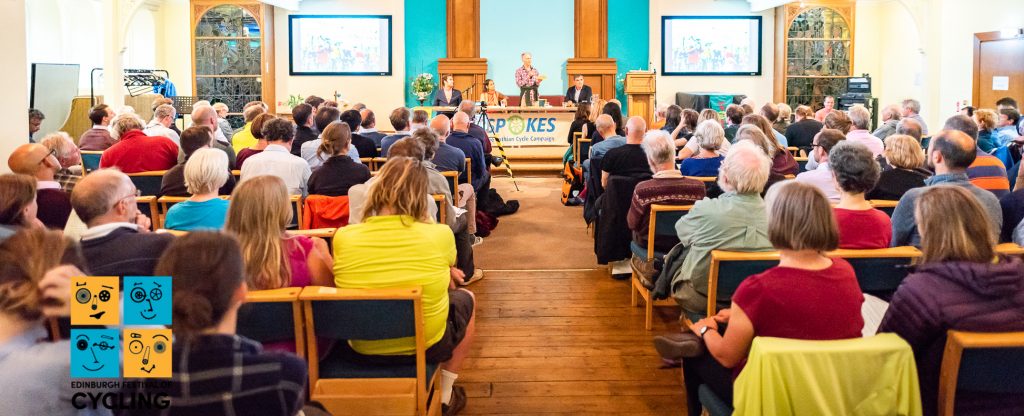
www.andycatlin.com
In addition to our three invited speakers, we were delighted that Councillor Anna Richardson, Glasgow City Council’s Convener for Sustainability and Carbon Reduction, also came along, to sit in the audience (she also got to make a few points from the floor during the QA – see below). Friendly rivalry between the two cities is undoubtedly hotting up!
Meeting resources
- YouTube live stream of meeting [meeting starts at 03:58 in timeline] by @ontwoplanks
- Presentation slides by Daisy Narayanan
- Presentation slides supplied by David Begg [Note: DB spoke without using the slides, but they relate well to what he said]
- #SpokesMtg tweets & pictures
- Meeting poster
- Spokes pre-meeting background article
- Daisy Narayanan background article by The Edinburgh Reporter
What you can do now
- Check out the article carefully. If you wish to take up and push any of the points, contact your councillors – find Edinburgh councillors at www.edinburgh.gov.uk/councillors and all the politicians who represent you at writetothem.com.
- Retweet the tweet of this article.
Introduction – Dave du Feu, Spokes
- Edinburgh city centre is falling behind European capitals in terms of traffic reduction and as a people-friendly place. The Gehl report [see para 1102 here] remains on the shelf after 10 years. Opportunities for traffic reduction, such as tram introduction or Picardy Place reconstruction, had not been taken. Recent cycle investment had nearly all been on the periphery of the city, politically easy because road space need not be taken from traffic.
- Perhaps as a result, recent Spokes traffic surveys suggested that the long-term city centre peak-period trends of rising bike use and falling car use were levelling off. A ‘transformation’ is needed – action, not just vision.
- Edinburgh is far ahead of Glasgow in terms of cycle use, thanks to consistent investment and policy over years and decades. However recent years have seen big change in Glasgow, with a flourishing bike-share scheme and significant segregated cycling provision. Edinburgh’s position is seriously threatened.
- To achieve substantial change in cycling provision, decision-makers require two equally-important qualities…
- understanding cycling’s potential as a transport mode
- having the guts to push ideas or projects which may be highly contentious.
- All 3 of the speakers have demonstrated both these qualities in their past actions – examples were given.
Daisy Narayanan – Leader, Edinburgh City Centre Transformation
-
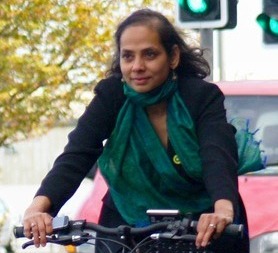
Daisy Narayanan, Deputy Director of Sustrans Scotland
Daisy is Deputy Director of Sustrans Scotland and a trained urban designer. She is seconded to Edinburgh Council, 4 days a week, for a year from April 2018.
- Jane Jacobs quote: “Designing a dream city is easy, rebuilding a living one takes imagination”
- The Transformation role and project are not just transport, but working across departments including input from housing, transport, planning & economic development
- There have been excellent past proposals and ideas, for example by Ricardo Marini and Jan Gehl, but none implemented – implementation is a major challenge.
- Edinburgh has a lot to offer, outstanding built heritage, public transport that works and a vibrant economy. City centre is monumental but on human scale. But Edinburgh faces challenges – 17% growth to 600k population by 2040, high cost of congestion, 95,000 commuting into city and 19,000 commuting out.
- The Transformation vision and outcomes need to be fun, equitable, safe and deal with conflicts: visitor v. resident; cyclist v. motorist, etc. They need to take account of some 22 existing city centre projects now underway or planned (not all transport, but including Meadows-George St and CCWEL).
- The project has set 5 aims and 15 objectives (see slide) which fit within the four themes of the 2050 Edinburgh City Vision – Fair, Connected, Thriving and Inspiring.
- The project takes inspiration from other cities such as Copenhagen where bike numbers exceeded cars in 2016, and many others including New York, Paris, Brussels, Barcelona, Oslo.
- To show that the ideas will be concrete, the Council is holding carfree events on Clean Air Day, June 21. [Later – on Clean Air Day it was announced that the Council is working towards regular car-free days in the city, as part of the Transformation process].
David Begg – Leader, Glasgow City Connectivity Commission
-
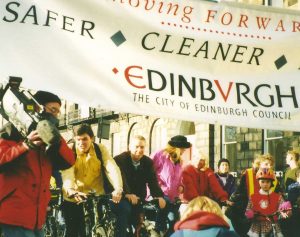
Councillor David Begg leads a proud Council bike ride to open the new Princes Street cycle lanes – sadly, removed by a later council due to the bike-hostile design of tramline layout.
David Begg is Chief Executive of Portobello Partnership Ltd which specialises in strategic advice in the transport sector and publishes Transport Times magazine, and a former transport advisor to the Labour government in the 2000s.
Most important for us, he was an imaginative and brave Transport Convener in Edinburgh (and the Lothians until the Conservative government scrapped the Regional Council) in the 1990s – including taking away car space to introduce the bus Greenways, banning cars and introducing cycle lanes in Princes Street – measures in part downgraded by later councils.
- Referring back to his time as a councillor, David said that as Transport Convenor he had given up his car, and had allocated 2% of the Transport capital budget to cycling – revolutionary at the time, though dwarfed by the 10% now in place.
- In the last few years Glasgow Council seems to have done better than Edinburgh on sustainable transport – including the Avenues project and trees on some of Glasgow’s wider streets. It was trying to move past its pro-car policies of the 1960s and 1970s (which Edinburgh politicians had managed – just – to reject).
- Edinburgh has the big advantage of 10% of population living in the city centre, Glasgow 3%. A key change would be for Glasgow (and indeed cities in general) to put some good schools in the centre to bring back families.
- Glasgow has 25% of its land allocated to roads whereas Edinburgh has 12%. Edinburgh also gives much more of its road space to pedestrians, as footways. Glasgow even has 1/3 more road space than “motor city” Birmingham. However this over-provision of roadspace gives great potential for change. Glasgow also has less green space – this needs to be increased.
- Glasgow has great transport inequality and 50% of Scotland’s deprived neighbourhoods. Low income people contribute least to environmental pollution through exhaust emissions etc., but suffer most from the consequences.
- Glasgow is suffering massive decline in bus usage (40% in a decade) whereas Edinburgh bus usage has grown. Although Glasgow has the best urban rail system outside London this is becoming increasingly crowded.
- The weak governance of transport in regional travel to work areas since abolition of the Regional Councils by the Conservative government [1996, see Spokes #61, p4] has made strategic action more difficult, whereas the new English mayors are now starting to do this.
- The work of Enrique Penalosa as Mayor of Bogota was hugely inspiring, based on his famous quote, “An advanced city is not one where the poor use cars, but one where the rich use public transport.”
- Constructive pressure from campaigners is vital, to encourage and support politicians. It is essential for this to continue in both Glasgow and Edinburgh.
Cllr Adam McVey – Leader, Edinburgh City Council
-
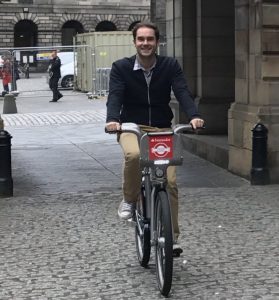
Council Leader, Cllr Adam McVey, trying out one of the demo Council hire bikes
Adam was Cycling Champion and Deputy Transport Convener in the previous Council, and has been Council Leader since the 2017 election. At 30, he may be Edinburgh’s youngest ever Council Leader. He was invited primarily to sit on the QA panel but also to give a short introduction following the presentations from the two project leaders.
- This administration intends to be the most pro-cycling ever. However their efforts are not just about particular transport modes – they want to improve the whole system, looking at how space is used.
- The number of visitors in the city centre is both a problem and an opportunity – we must preserve the beating heart of the city.
- There is a lot in progress on cycling – two-thirds of Leith Walk is complete, planning is well underway on the East-West route through city centre, and there are also the two major Community Links Plus projects.
- Past councils have spent far too long debating changes – now we will move forward with long delayed schemes like cycle hire and residential cycle storage.
QA – Speakers’ panel, chaired by Kirsty Lewin
-
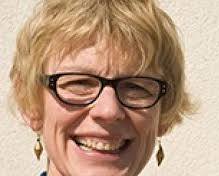
Kirsty Lewin
Kirsty is a board member of Sustrans Scotland and a long-standing member of Spokes
- Key:
- DN Daisy Narayanan
- DB David Begg
- AM Adam McVey
- KL Kirsty Lewin
- Q Audience questioner
- Note – some Qs/answers have been combined below where on a similar topic even if not concurrent in the session.
- KL – Bogota Ciclovia great example for Edinburgh Transformation, streets regularly closed and attracting over 1m people for huge range of non-motorised activity
- Q [Graham Hart] – Routes into city centre essential as well as centre transformation. AM – funding not limitless, and centre is top prioirity. DN – Transformation boundary is porous and connectivity matters. Q [Cllr Anna Richardson] – Arterial routes vital and Glasgow is delivering these; area-based projects also important, to cater for local everyday activity, not just commuters.
- Q – Craigmillar undergoing much development; opportunities to develop bike use may be missed. Q – Niddrie Mains Road cycle/pedestrian path allowed to deteriorate. AM – will look into this.
- Q – Citywide 20mph very valuable, but many drivers still disobeying. AM – average speeds in city have fallen and council [who pay towards the police] have made this a priority. Literally 100s of drivers stopped by police so far. Vital to change the culture; everyone can help by speaking up for kids, shopping safety etc, when colleagues or friends complain. DB – with future partially autonomous vehicles councils could control max speeds electronically; we must fight for this as motoring lobby will oppose.
- Q [Cllr Chas Booth] – Buses suffering from congestion, can Transformation assist this? DN – Lothian Buses represented on Transformation team; maintaining & improving bus services is a central issue. Looking at bus re-routing and using electric hopper buses in very centre e.g. Princes Street. DB – Bus Greenways have been allowed to deteriorate in quality. Bus income should be ringfenced for Greenways improvements. Bus speed is critical to increasing patronage, so congestion a serious danger – councils should set targets to increase bus speeds – Leeds is doing this.
- Q – Bus lane/ Greenway hours of operation – very unhappy with decision by previous council to cut back on hours. AM – willing to revisit this decision if there is evidence for doing so.
- Q – Small works (continuous footways, dropped kerbs) are critical to a successful well-used public realm. DN – the Transformation Action Plan will include packages of work both strategic and detailed.
Speaker final summings up
The speakers were asked to say briefly what they would take away from the meeting…
- DB – Edinburgh in general is in good hands, but great concern about the cuts in bus Greenway times and quality – these are vital to continue growing patronage. Secondly, the importance of small items in the overall Transformation – zebra crossings, advanced stop areas, dropped kerbs, etc.
- DN – Leadership is vital but must come from ‘bottom up’ – i.e. individuals and groups – as much as from the top. There is some cynicism about whether the Transformation will be worthy of that word, but continuing support like from the people tonight is inspiring and can make it happen.
- AM – Funding is critical, and the Council’s 10% cycle allocation is a base budget, not a limit. Also, there are other sources – e.g. for small items like drop kerbs, lining, etc the 4 Localities have their own budgets (contact via your councillors).
- KL – Spokes public meetings are the best in Edinburgh, and the audience tonight was fantastic!
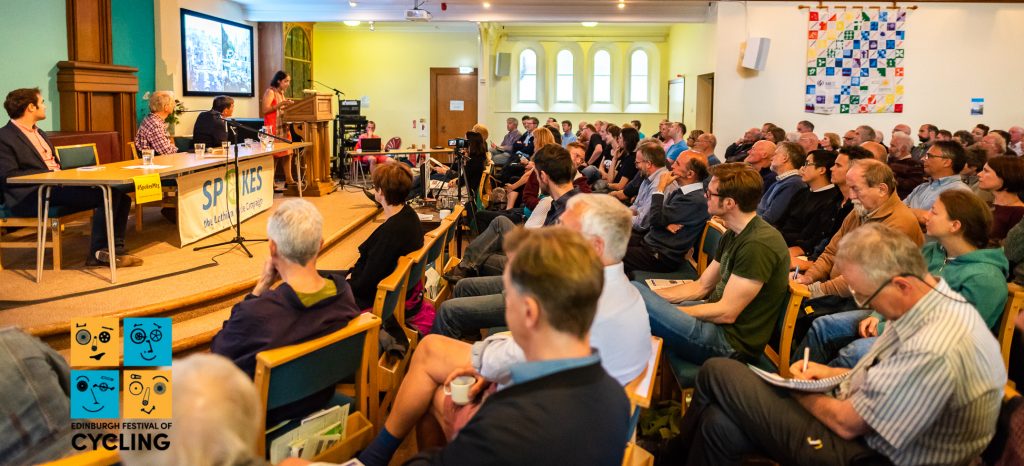
www.andycatlin.com
